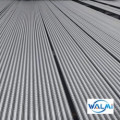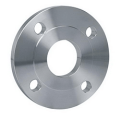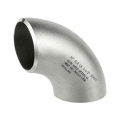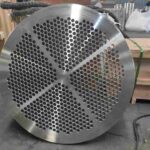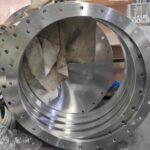Stainless Steel Tubesheets: A Solid Support in Industrial Manufacturing
Across the vast field of industrial manufacturing, stainless steel tubesheets, as key structural components, are widely used in various equipment, including heat exchangers, pressure vessels, and boilers, performing multiple functions, including connection, support, and heat transfer. Today, through several photos from our workshops, we’ll delve into the world of stainless steel tubesheets and learn about their manufacturing process, characteristics, and applications.
A First Look at Stainless Steel Tubesheets
As the name suggests, stainless steel tubesheets are tubular structural sheets made of stainless steel. They are typically circular, perforated metal sheets, primarily used to secure and seal steel tubes. In equipment like heat exchangers, the tubesheet acts as a “base camp,” neatly arranging and securing numerous heat exchange tubes, forming an orderly heat transfer network. Furthermore, the tubesheet connects to other components, such as the shell, and withstands various loads, including pressure and temperature, from the equipment.
The photos from our workshops reveal the true nature of stainless steel tubesheets. These tubesheets typically have a large diameter and a certain thickness, with a regularly arranged pattern of holes on their surface. These holes require extremely high precision. Their size, spacing, and position are carefully designed and machined to ensure accurate insertion and securement of the heat exchange tubes. As shown in the image, the holes on the tube sheet are neatly arranged, each a testament to the exquisite craftsmanship.
Exquisite Manufacturing
Manufacturing stainless steel tube sheets is a complex and delicate process. First, material selection requires choosing the appropriate stainless steel grade based on the equipment’s operating conditions, such as temperature, pressure, and media. Common stainless steel grades include 304 and 316, which offer excellent corrosion resistance, high-temperature resistance, and mechanical properties.
Once the material is selected, the process begins. Tube sheet processing primarily involves cutting, drilling, and tapping. Cutting is used to shape the stainless steel sheet into the desired shape and size. Drilling creates the holes for the heat exchange tubes, a step that demands extremely high precision and requires a high-precision drill press and specialized tooling. Tapping creates threads within the holes for installing bolts and other fasteners.
In the workshop, we can observe the different stages of the tube sheet manufacturing process. Some tubesheets are freshly drilled, their holes still retaining the sheen of metal processing; others are fully machined, with smooth surfaces and regularly arranged holes. Every step in the manufacturing process is rigorously controlled to ensure that the tubesheets meet high quality standards.
Excellent Performance
Stainless steel tubesheets are widely used in industry due to their exceptional performance. Stainless steel possesses excellent corrosion resistance, enabling long-term stable operation in a variety of harsh media environments, such as acidic, alkaline, and saline. This ensures reliable operation of equipment in the chemical, petroleum, and pharmaceutical industries, reducing corrosion-related equipment damage and repair costs.
Stainless steel also offers excellent high-temperature resistance, maintaining strength and stability in high-temperature environments. In some high-temperature heat exchange equipment, stainless steel tubesheets can withstand the impact of hot media, ensuring normal operation. Furthermore, their high strength and hardness allow them to withstand the various loads during operation, ensuring the structural integrity of the equipment.
Wide Applications
Stainless steel tubesheets are used in nearly every industrial application requiring heat exchange, sealing, and support. In the chemical industry, heat exchangers are common equipment. Stainless steel tubesheets, as their core components, facilitate heat exchange between different media. In the power industry, boiler tubesheets also play a vital role, enduring the impact of high-temperature, high-pressure steam and water. In industries such as shipbuilding and food processing, stainless steel tubesheets are also widely used for their excellent corrosion resistance and hygienic properties.
As an indispensable component in industrial manufacturing, stainless steel tubesheets, with their sophisticated manufacturing processes, excellent performance characteristics, and wide range of applications, have become a vital guarantee for the stable operation of industrial equipment. With the continuous development and advancement of industrial technology, stainless steel tubesheet manufacturing technology will continue to innovate and improve, providing stronger support for the development of various industries. Seeing these tubesheets meticulously crafted in the workshop again, we can’t help but have a deeper understanding of the charm and power of industrial manufacturing.


